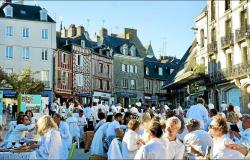Pfor the 4e stage of the Tour de France, linking Dax to Nogaro on July 4, the riders will compete in an intermediate sprint in Labastide-d’Armagnac (Landes). There is therefore little chance that they will take the time to dismount to salute a unique sanctuary in France, dedicated to all cyclists and cyclists. The Tour has always liked to honor its own memory. That day, the departure from Dax will be a nod to André Darrigade, the “Lévrier des Landes”, the oldest French champion still alive at 94 years old, whose statue as a giant cyclist sits on the roundabout of Narrosse, his hometown; the arrival in Nogaro will be another for the Spaniard Luis Ocaña, winner fifty years ago of the 1973 edition, who came to take over a farm in the surrounding area. In 1966, Ocaña was married at the Notre-Dame-des-Cyclistes chapel; in 1994, his funeral took place there; that day, his rival, Eddy Merckx, was one of the four champions to carry his coffin. But this chapel, which is not dedicated to any champion in particular, belongs to all cyclists exposed to the risks of the profession or the road and placed under its high protection.
If there is one figure to distinguish, it would be that of the cassocked founder of this sanctuary, Father Joseph Massie (1912-1999). A Basque Don Camillo, son of a bicycle salesman, who made bicycle rhyme with credo. Appointed head of the parish of Créon-d’Armagnac, it was during a heavy rainstorm forcing him to celebrate the service there that he discovered in 1958 this chapel called Géou, dating from the 12th century.e century and disused. “It was covered in ivy. He went to get the key from a neighbor’s house. During the mass, an idea came to him: what if we dedicated it to cyclists? But the mayor wanted to shave it. As for the bishop of Aire and Dax, he did not want to upset the mayor. So, Father Massie got on his bike and pedaled to Rome to convince Pope John XXIII to help him.tells us Ginou, 90 years old, one of the memories of the association that is in charge of the place. This is how in 1959, Notre-Dame-de-la-Visitation received the status of patron saint of cyclists. At the time, there was already an official place of pilgrimage for cyclists: it was located in Italy, near Lake Como, at the chapel of the Madonna del Ghisallo, recognized by Pope Pius XII in 1949. Faith has always been a part of the calves in the country of the great Gino Bartali, known as Gino the Pious, who multiplied acts of piety and saved Italian Jews during the war by operating on a bicycle as a liaison agent. Because a bicycle can also save lives. We discover it at the Yad Vashem memorial in Jerusalem when we see Marie-Rose Gineste’s machine hanging from a ceiling. It was by bicycle that the secretary of the Bishop of Tarbes distributed the apostolic letter of August 23, 1942, in which Bishop Théas publicly spoke out against the deportations of Jews in France carried out by the government of Marshal Pétain.
When Félix Levitan, then director of the Tour, learned that there was finally a cycling sanctuary, he sent a congratulatory telegram to the good abbot and promised to come and see him. It took almost thirty years. In the meantime, hundreds of champions had handed in their jerseys, yellow or not so yellow, at the chapel. Darrigade was the first, followed by Robic, Bobet, Poulidor, Anquetil, Merckx, Thévenet, Hinault, Jeannie Longo, LeMond… On July 9, 1989, to celebrate the chapel’s 30th anniversary, the Tour set off from Labastide-d’Armagnac; that day, Abbé Massie blessed the riders, including the leader in the general classification, the American LeMond, who presented him with his golden fleece, which the man of the Church immediately donned. It is said that Fignon was so upset that he later refused, after this Tour de France that he lost by an unfortunate 8 seconds, to send a jersey in turn. Only one yellow jersey was removed from the collection, that of Lance Armstrong, seven-time winner of the Grande Boucle, after he was convicted of doping. Claude Nadeau, president of the association, received several letters asking him if he would remove others, if there would even be any left. He did not respond. Inside the chapel, all these jerseys – nearly 900 – look like large colored ex-votos. The stained glass windows were made by a famous French cyclist, Henry Anglade. In particular, he represented the famous Poulidor-Anquetil duel on the Puy-de-Dôme in 1964. Several bicycles are exhibited, including the fixed-gear bicycle of Léon Georget, who completed the first Tour on it in 1903. Curiosity: the first folding bicycle, which the cycling companies had in the trenches in 1914. Each year, more than 10,000 cyclists, including pilgrims to Compostela, stop to pray at Notre-Dame, light a candle and entrust their pedals to the good care of the Virgin.
Martyrology. Since 1903, the Tour de France, conceived as a moment of national communion, placed under the sign of energy and suffering, a celebration of victory and an atonement for failure, has also erected its own secular sanctuaries. The farm where Eugène Christophe, in 1913, straightened his broken fork himself in Sainte-Marie-de-Campan, in the Pyrenees. The 70 meter deep ravine, at the Col de l’Aubisque, from which the Dutchman Wim van Est was miraculously brought up alive in 1951. The rock of the Col de Menté, on which Luis Ocaña came crashing down in 1971, losing all hope of win over Eddy Merckx the Cannibal. On a small road, in Damiatte, in the Tarn, a stele sums up, with the laconicism of a fatal epitaph, the bad luck of our national Poupou: “Here, on July 14, 1968, Raymond Poulidor, knocked down by a motorcycle, lost all chance of winning the Tour de France.” The year before, Tom Simpson had died, zigzagging in the heatwave during his ascent of the bald god, Ventoux. In 1995, a few months after the death of the rider Fabio Casartelli, a monument was erected to honour the memory of the Italian rider who had fallen on the descent of the Col de Portet-d’Aspet. The Tour has its martyrology, which traces another map of France, heroic, dolorous, branded with a hot iron of his tragic feats of arms.
To describe the summer epic provided by the Tour, Roland Barthes, in Mythologiescharacterized the runner as ” andtotal man grappling with a Nature-substance […] it is its connection to the ground that defines it, often in anguish and apocalypse.” Sometimes a superman, he overcomes all trials. Sometimes, he reminds us that he is only a man. In this battle with himself and with a landscape that is both sublime and hostile, he seeks support. He finds it in scientific preparation, team solidarity, but also in superstition rites or in divine protection to which he entrusts his sacrifice. Everything is good to take. « Dieu, declared Abbot Massie, it is the finish line, an outcome. » It is not certain that Tadej Pogacar or Jonas Vingegaard think of God as they cross the line, but the knights of the little queen, who know they are vulnerable, often turn to the sky, and not just to scan the weather. Rocket men launched into the descents at breakneck speed, they know that the road can become their tomb. By passing Notre-Dame-des-Cyclistes on July 4, the Tour will reaffirm the processional dimension of a caravan as colorful as our era: it will come to place itself under its protection, hoping that all will go well – better at least than for Gino Mäder, the great Swiss hope, who died on June 16 at the bend in a road – until Paris and its Champs-Élysées, which promise eternity to the blessed ones who arrive safely.






